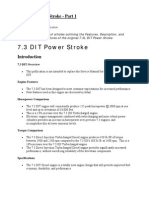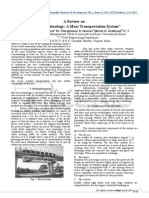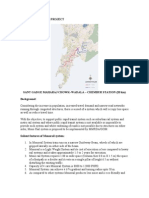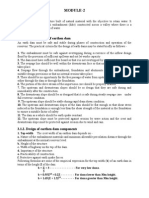0 ratings0% found this document useful (0 votes)
46 viewsRailway Control: Control of Train Movements
The document discusses control systems for train movements on Indian Railways to ensure safety. It describes the time interval system, which dispatches trains based on time elapsed since the previous train's departure but fails if the previous train is delayed. It also describes the space interval system, which only allows one train at a time to occupy a particular length of track, guaranteeing safety as only one train is in motion at a time.
Uploaded by
sakshiCopyright
© © All Rights Reserved
Available Formats
Download as DOCX, PDF, TXT or read online on Scribd
0 ratings0% found this document useful (0 votes)
46 viewsRailway Control: Control of Train Movements
The document discusses control systems for train movements on Indian Railways to ensure safety. It describes the time interval system, which dispatches trains based on time elapsed since the previous train's departure but fails if the previous train is delayed. It also describes the space interval system, which only allows one train at a time to occupy a particular length of track, guaranteeing safety as only one train is in motion at a time.
Uploaded by
sakshiCopyright
© © All Rights Reserved
Available Formats
Download as DOCX, PDF, TXT or read online on Scribd
You are on page 1/ 1
RAILWAY CONTROL
CONTROL OF TRAIN MOVEMENTS
The system adopted for controlling the movement of trains should be such that it allows the trains to run in
either direction as well as facilitates faster trains to overtake slower trains, thus ensuring the complete safety
of trains. The following systems are chiefly used for controlling the movement of trains on Indian Railways.
i)
Time interval system
In this system, there is a time interval between two successive trains. A train is dispatched
only after sufficient time has elapsed since the departure of the previous train. This system
works fine just as long as everything goes well with the previous train, but if there is a
mishap and the previous train is held up, the system fails, jeopardizing the safety of the
trains.
ii)
Space interval system
In this system, there is a space interval between two consecutive trains. Only one train is
permitted to occupy a particular length of the track. A succeeding train is permitted to occupy
the same track length from either side only after the first train has cleared it. This system
guarantees safety as only one train is in motion at one time.
You might also like
- OSHA 30 Construction Final Test Answer Key71% (153)OSHA 30 Construction Final Test Answer Key74 pages
- OSHA 10 Hour General Industry Final Exam Answer Key75% (12)OSHA 10 Hour General Industry Final Exam Answer Key11 pages
- OSHA 10 Construction Final Exam Answer Key77% (13)OSHA 10 Construction Final Exam Answer Key18 pages
- Truck and Transport Mechanic-Practice Interprovincial Red Seal Exam80% (5)Truck and Transport Mechanic-Practice Interprovincial Red Seal Exam36 pages
- MaxxForce 7 Diesel Engine Repair & Service Manual - 043% (14)MaxxForce 7 Diesel Engine Repair & Service Manual - 014 pages
- DT 466 / DT 570 Diesel Engine Diagnostic Manual97% (37)DT 466 / DT 570 Diesel Engine Diagnostic Manual665 pages
- Alert Indicators: Operation and Maintenance Manual100% (5)Alert Indicators: Operation and Maintenance Manual6 pages
- About Signaling System in Indian RailwaysNo ratings yetAbout Signaling System in Indian Railways3 pages
- 26.concurrent Train Simulation 9949979434No ratings yet26.concurrent Train Simulation 99499794345 pages
- IRSE Fundamental Requirements For Train Control Systems (v8.1)No ratings yetIRSE Fundamental Requirements For Train Control Systems (v8.1)5 pages
- Fundamental Requirements For Operations and Signalling (Version 4)No ratings yetFundamental Requirements For Operations and Signalling (Version 4)3 pages
- Trainspotting A WSN-Based Train Integrity SystemNo ratings yetTrainspotting A WSN-Based Train Integrity System6 pages
- Automatic Railway Gate Control & Track SwitchingNo ratings yetAutomatic Railway Gate Control & Track Switching2 pages
- (Metro System and Engineering) - Subhadip BhattacharyaNo ratings yet(Metro System and Engineering) - Subhadip Bhattacharya8 pages
- Rainnig Eport T Oach ARE Omplex Orth Esten Ailway Aipur: T R A C C C N W R JNo ratings yetRainnig Eport T Oach ARE Omplex Orth Esten Ailway Aipur: T R A C C C N W R J21 pages
- Presentation On Indian Railway: Presented by-HARIOM GAUTAMNo ratings yetPresentation On Indian Railway: Presented by-HARIOM GAUTAM17 pages
- IRSE Fundamental Requirements For Train Control Systems (V1a - Sept 2019)No ratings yetIRSE Fundamental Requirements For Train Control Systems (V1a - Sept 2019)5 pages
- Hyper Loop: Guided by Mr. Kiran M S Asst - Professor Presented by Sunil V 1AT15CV079No ratings yetHyper Loop: Guided by Mr. Kiran M S Asst - Professor Presented by Sunil V 1AT15CV07914 pages
- Sistem Manufaktur Dan Teknologi Perakitan: Agus Riyanto, Ir., MMNo ratings yetSistem Manufaktur Dan Teknologi Perakitan: Agus Riyanto, Ir., MM7 pages
- Report of Educational Visit TO Railway Station, Renigunta JunctionNo ratings yetReport of Educational Visit TO Railway Station, Renigunta Junction12 pages
- Implementation of Train Collision Avoidance andNo ratings yetImplementation of Train Collision Avoidance and20 pages
- Data and Measurement of Elements of Climate 1) Measurement of Temperature100% (1)Data and Measurement of Elements of Climate 1) Measurement of Temperature2 pages
- Module-2: 3.1.1. Design Criteria of Earthen DamNo ratings yetModule-2: 3.1.1. Design Criteria of Earthen Dam9 pages
- Transp Ortation 101:: Implementin GAN Effective Safet Y Progr AM100% (2)Transp Ortation 101:: Implementin GAN Effective Safet Y Progr AM9 pages
- Ultimate Survival Skills Handbook and Checklist100% (25)Ultimate Survival Skills Handbook and Checklist88 pages
- Improving Your Self-Esteem: Information For ClientsNo ratings yetImproving Your Self-Esteem: Information For Clients12 pages
- Chapter 1 (Introduction To Servicing Heavy-Duty Trucks) 1No ratings yetChapter 1 (Introduction To Servicing Heavy-Duty Trucks) 116 pages
- ASVAB Mechanical Comprehension Practice Test 3No ratings yetASVAB Mechanical Comprehension Practice Test 38 pages
- Recovery From Nuclear Attack - FEMA 160.1988 PDF100% (1)Recovery From Nuclear Attack - FEMA 160.1988 PDF24 pages






























































































